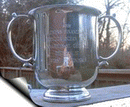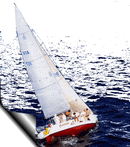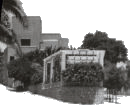
The Race: Email send after we returned to Annapolis
Team:
Let add one more item to the list. I should have constantly revised my assumptions, but did not. At the beginning of the 2002 preparation my overall concern was low free board and overall weight and I initially planned to race with a total of only five people. It was Howard, who with his large offshore experience on his J/35, had convinced me that six was a better number. The 2002 race with six people went so well and the return with five people also went quite well.
Thereafter, I lost a bit track of my reduced safety margin there. The more weight and the more people we have the less safety margin we have. A total of five is good for a J/105 if we do not have to douse around marks and can plan all sail changes well in advance. The shifts are not as smooth and there is more fatigue involved for everybody.
Jaffar
-----Original Message----- From: Jaffar Bentchikou Sent: Wednesday, June 16, 2004 12:04 PM To: Santiago Dellepiane ; Chad McMullin ; James Timberlake ; Jon Doyle ; Mike Jewell ; Paul Hillier Subject: What happened? Why? What's next?
Team:
I do not know about you, but I was quite down with our broken dream on Sunday, but fortunately a few friends and family members called and Monday was much better. I am almost trough drying the sails, the boat and the cushions. These cushions are real sponges and they are so slow to dry. I need to replace them with closed cell foam, ASAP. Mike, let me know if you have already talked to the person you mentioned who might help there. I looked back to what we did, I have talked to Bob Muller, TPI (the builder of US J/105s), the Flex-O-Fold prop engineer as well as a few others and I have inspected a few other J/105s, including my old Jay Boat. Here is the result of that analysis.
++ What happened?
1) I had overloaded the bow.
2) We took water through the bowsprit opening with each wave we hit after we doused the spinnaker. I believe the spinnaker tackline kept lifting the bow when it was used and the problem was already there but became worse after we doused the spinnaker. The bowsprit is inside a sleeve running from the bow to the bulkhead between the anchor locker and the forepeak cabin. The sleeve has an opening at the bottom and drains into the anchor locker. The main problem was that the flow of water at the bowsprit opening was greater than the flow of water draining out of the anchor locker as the diameter of that drain is quite small. So the anchor locker filled and stayed filled and then the overflow went inside the forepeak cabin through the opening for the bowsprit.
3) We did not recognize in time that we had a major problem in hands. We had isolated comments and remarks on the bow being down or the anchor locker being full of water but I did not analyze this information properly at that time. We had no water alarm in the forepeak and no alarm bell went on in my mind. I was not mentally sharp. The move or the anchor out of the anchor locker was too little too late.
4) The bilge pumps did not work as well as anticipated and we, as a team, had some hiccups in our reaction to the emergency.
++ Why?
1) The overloaded bow was a consequence of the new float lines. I will double check their accuracy next time I haul out the boat. Contrarily to plans, I rushed the loading and at the last moment, decided to take more water than my original plan to minimize the need to drink water from the boat's water tank and in the rush, put that additional water in the forepeak without checking the float lines. Furthermore, I did not check the float lines after the loading was completed with all the stuff loaded, particularly the 100 lbs liferaft.
1 bis). The rushed loading was due in particular to:
* Focusing for too long on the non-performing instruments; I had to have long telephone discussions with the Nexus guy, un-mount and FedEx to him the compass transducer, then reinstall it, install the new remote and perform a board transplant for the Nexus server. For doing that I even had to get a new cellular phone.
* Major worries about the noise at the cutlass bearing and the propeller shaft vibrations, which lead to an inspection by our diver and a change of zinc and zinc position, which solved the noise problem but not the vibration. I am now told by the Flex-O-Fold guy that I need to haul out the boat and check the propeller installation, as it may be riding too high up the radius at the forward end of the keyway. Maybe, I should have ordered the new propeller in the fall of last year and installed it earlier in the season. But the idea of redoing the bottom paint close to the BOR has also some merit and this was the plan I followed.
* About everybody involved in boat preparation was late. A bit here and there finally added up to a major problem. The transducer fix was installed only the Monday of the race week. The Globalstar phone was delivered to us only on Thursday and the Ocens Weathernet software that was included was quite difficult to install properly. We had two CDs in the package and only one was to be used and of course I started the installation by using the wrong one. The instructions were pitiful and my call to Assistance was only returned on Friday morning. The emergency navigation lights were a major source of problems as I spend too much time looking for a better solution than the one we finally adopted (by the way, in 2002 we had battery-powered lights that are now specifically prohibited by the inspector). Then the supplier did not have the parts in stock (contrarily to what was said when I placed the order) and had to substitute a different system that was a major headache to install. The BOR papers were also filled late because a couple of team member waited until the very last moment to sign the release form and provide the information needed.
* Overall, I had less preparation help than in 2002. The video was a major distraction and only three people provided help on the boat, and it was extremely valuable, thank you again.
* None of the race crew signed up for the return this time, contrarily to 2002, and I had to spend a major portion of my time and energy looking for appropriate return crew.
2) We took lots of water through the bowsprit sleeve due to a bad seal design. This was acknowledged by J/Boats in a technical bulletin issued April 24, 2001. I was aware of that but because my boat was ordered in June 2001, I thought that I had the newer design. But I have checked now and I was mistaken. Bob Turner, the owner of Kiva told me that a J/160 had a similar problem in the 2003 Charleston - Bermuda race. We were obviously taking too much water at the seal, filled up the anchor locker quickly and then it overflowed into the forepeak cabin. I calculate that we had about two metric tons of water when the water started to overflow into the main cabin and the forepeak mattresses were floating on top the forepeak water. That is 4500 lbs of water for a boat that weights 8000 lbs unloaded and a bit less than 11000 lbs when we left the dock on Friday. Huge amount!
3) We did not practice with the boat as fully loaded as we were at the start of the race. We practiced as a team only on weekend, but what a glorious weekend that was! Two of you did not race at all with us since the 2002 BOR and had lost familiarity with Chantecler. Only two of you had raced with the team in 2003, which was a preparation year for the 2004 BOR. Preparedness and practices are the keys to doing well offshore and we were less than optimum there.
4) For some reason, the team that seemed coming together nicely during the Miles River weekend, started to break down during the race and the emergency. The flow of information and decision making on Bay strategy became strained. We did not use properly all the information we had painfully gathered on the web, at the two weather seminars (Thursday afternoon and Friday morning), from Jeff Todd on Friday morning, and from watching what the rest of the fleet was doing. We had some confusing moments during the emergency because we were not sure about the source of the leak and the three bilge pumps were not working properly together. Some focused on getting the water out of the forepeak and rebalancing the boat while others simply waited to be told what to do. We were more smooth during the 2002 return when we got a similar emergency. The difference is however that at that time, there was good weather (last Friday we had a storm and heavy rain outside), daylight, and also we had found the source of the leak quite early and plugged it.
++ What is next?
First, fix the boat. I have ordered the new bowsprit seal and Bob Muller will lift the boat to check the propeller. He will also, build a custom-made funnel around the bow sprit sleeve and drain any water coming through the new seal, directly outside through a new through-hull instead of letting that water drain into the anchor locker. He will also install two new through-hulls for setting up completely independent systems for all three bilge pumps. Also, he will install a water alarm in the forepeak bilge. I need also professional help for replacing the boat cushions with closed-cell foam. Mike knows somebody who could do that but if you have any other reference, please let me know.
Second, take revenge and do well at the Solomons race on Friday July 16 and the Governor's Cup on Friday August 6. I would love to have most of the BOR team (I know that Jon is too far away) together for at least one of the two races. Let me know early what are your individual sailing / racing plans in the near future. I would appreciate an email or a phone call in the next few days.
Third, I plan to take the time to think about the future of Team Chantecler. The J/105 Annapolis fleet has decided last Saturday to change keels in bulk and the class racing will be DD next year. This is welcome news and gives us more options. Fleet racing is very attractive, but so is offshore racing.
I, of course, welcome any comment on the above.
Jaffar
PS:
Do you remember the good feel we had when we finally passed Swift, the Navy 44 that was sitting on our air?
At that time we were in fifth position overall but soon after we doused the spinnaker we started to fall back. According to the BOR web site, at the 1800 position check on Friday we were in fifth position in the Division, a full 7 nm behind Vigilant, followed by Wharf Rat, Io and Dirigo but still ahead of Swift and Orion. We had been slow for quite a while when the positions were recorded and soon had to turn around. We had lost these 7 nm quite rapidly.
Since then, Swift has been leading the overall race in the Ocean, ahead of all Division 1 boats, having followed a Southern route, but the fleet is now catching up in light air and the first place overall seems up for grabs.
![]()
This site was last updated 05/08/10



